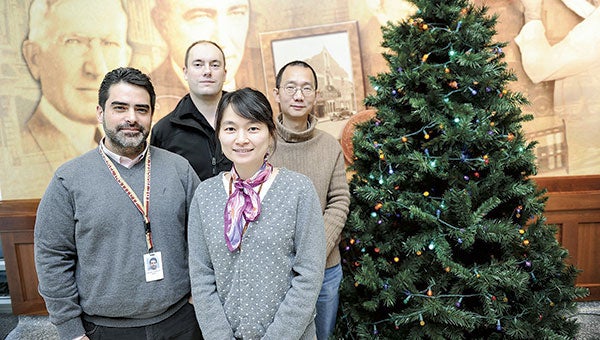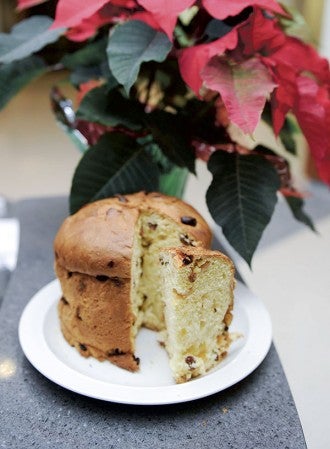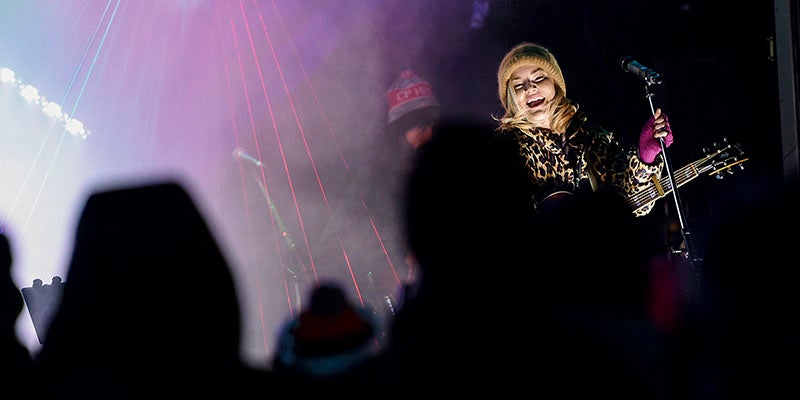Worldwide Christmas; Four scientists from four different cultures share their celebrations
Published 7:03 am Thursday, December 25, 2014

The Hormel Institute offers a variety of people from around the world working together. It offers a look into how people from different countries celebrate Christmas. Pictured are Sergio Gradilone of Argentina and Do Young Lim from South Korea in the front and James Robinson from England and Yong Li from China. Photos by Eric Johnson/photodesk@austindailyherald.com
Some people have to have pork, goose or turkey for Christmas dinner. Other people marathon classic Christmas shows. And there’s always one cartoon every family needs to watch during the Christmas season.
Yet people around the world have wonderfully different traditions to celebrate the winter season, including some of the researchers at the Hormel Institute.
“Christmas is always a fun time of year,” said James Robinson, an Institute scientist.
Robinson, who is from the United Kingdom, has fun explaining the differences between Christmas in the U.K. and Christmas in the U.S. Among the many traditions in the U.K. is the annual address from the Queen, burning letters to Santa in the fireplace (so they get to the North Pole directly where Santa can read them from the smoke) and putting presents around each bed instead of under the Christmas tree.
Of course, sometimes Christmas involves getting together with family and friends, whether it be down at the pub before Christmas Mass or at a relative’s house for a feast like none other.
Scientist Sergio Gradilone remembers Christmases in Argentina, where everyone came together on Christmas Eve for a big party that usually started at night.
Those parties are all about the food, according to Gradilone.
“Everything revolves around food,” he said. “Late dinners are usually around 9 p.m., so we start eating around that time.”
After the big meal comes more food, with a sweets table that includes pan dulce (sweet bread) and other traditional treats. Argentina shares much of its heritage with the Spanish and Italian settlers who came to Argentina many years ago, so there are many European dishes to eat.
“We are in summer there, but we have a tradition from Italy that’s about Christmas,” he said with a laugh.

Sergio Gradilone, from Argentina, brought a pan dulce, a sweet bread enjoyed during Christmas in Argentina.
Everyone toasts at midnight, while the children are up waiting for Santa to bring gifts. The party continues until about 3 or 4 a.m., then everyone sleeps in until the late morning or early afternoon, when they eat yet another prepared meal.
Of course, not everyone gets together on Christmas Day to celebrate the winter season. In some places, people reserve their celebrations for the Lunar New Year.
Yong Li and his family enjoyed Austin’s Christmas traditions, especially during Christmas in the City.
“I took my daughter,” the Institute researcher said. “We made animals, it was very fun.”
Yet in China, where Li is from, Christmas is more of a shopping day than a day to come together. People usually come together during the Lunar New Year, where families and friends get together to celebrate new beginnings.
“During the holiday in China, I think more than a half billion people go back to their homes, during that one month, for family reunions,” he said.
That means a lot of traffic problems in the spring, according to Li.
Chinese families will take part in many activities and participate in a local festival meant to celebrate the new year. For Li, it means calling his parents and watching the annual New Year TV celebrations.
Scientist Do Young Lim shares similar traditions with her family in South Korea. Yet Lim remembers having a Christmas tree when she was little, as many people in Korea are Christian and celebrate Christmas.
Christmas in Korea is a little different, however, as many people don’t get together with families as much.
“We still expect Santa Claus and presents,” she said.
Yet South Korea recognizes Christmas as a national holiday, as they do the Buddha’s birthday during the summer. Lim said many South Koreans enjoy recognizing both holidays as it usually means a day off from work.
The Christmas season does come with similar community traditions in South Korea. Each year, many South Koreans buy a seal — similar to a postage stamp, but not considered an official stamp — from the country’s tuberculosis foundation as a tradition, similar to the way many Americans give to the Salvation Army’s kettle drive.
One tradition remains common among cultures, however. Each country celebrates the holidays with great food.
“I went to a Christmas dinner last year,” Lim said. “They had a huge, huge dinner. I was very impressed by them.”



